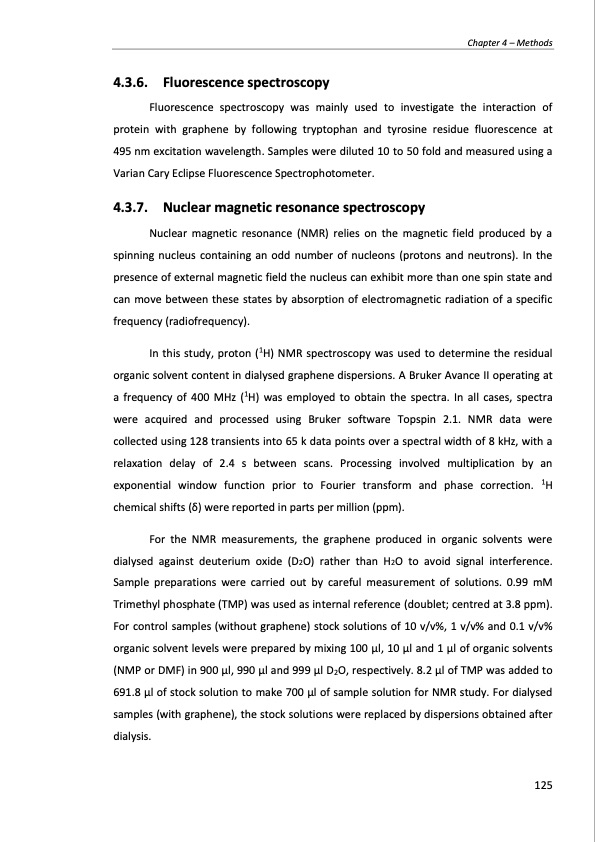
PDF Publication Title:
Text from PDF Page: 125
4.3.6. Fluorescence spectroscopy Fluorescence spectroscopy was mainly used to investigate the interaction of protein with graphene by following tryptophan and tyrosine residue fluorescence at 495 nm excitation wavelength. Samples were diluted 10 to 50 fold and measured using a Varian Cary Eclipse Fluorescence Spectrophotometer. 4.3.7. Nuclear magnetic resonance spectroscopy Nuclear magnetic resonance (NMR) relies on the magnetic field produced by a spinning nucleus containing an odd number of nucleons (protons and neutrons). In the presence of external magnetic field the nucleus can exhibit more than one spin state and can move between these states by absorption of electromagnetic radiation of a specific frequency (radiofrequency). In this study, proton (1H) NMR spectroscopy was used to determine the residual organic solvent content in dialysed graphene dispersions. A Bruker Avance II operating at a frequency of 400 MHz (1H) was employed to obtain the spectra. In all cases, spectra were acquired and processed using Bruker software Topspin 2.1. NMR data were collected using 128 transients into 65 k data points over a spectral width of 8 kHz, with a relaxation delay of 2.4 s between scans. Processing involved multiplication by an exponential window function prior to Fourier transform and phase correction. 1H chemical shifts (δ) were reported in parts per million (ppm). For the NMR measurements, the graphene produced in organic solvents were dialysed against deuterium oxide (D2O) rather than H2O to avoid signal interference. Sample preparations were carried out by careful measurement of solutions. 0.99 mM Trimethyl phosphate (TMP) was used as internal reference (doublet; centred at 3.8 ppm). For control samples (without graphene) stock solutions of 10 v/v%, 1 v/v% and 0.1 v/v% organic solvent levels were prepared by mixing 100 μl, 10 μl and 1 μl of organic solvents (NMP or DMF) in 900 μl, 990 μl and 999 μl D2O, respectively. 8.2 μl of TMP was added to 691.8 μl of stock solution to make 700 μl of sample solution for NMR study. For dialysed samples (with graphene), the stock solutions were replaced by dispersions obtained after dialysis. Chapter 4 – Methods 125PDF Image | PRODUCTION AND APPLICATIONS OF GRAPHENE AND ITS COMPOSITES

PDF Search Title:
PRODUCTION AND APPLICATIONS OF GRAPHENE AND ITS COMPOSITESOriginal File Name Searched:
graphene-production-applications.PDFDIY PDF Search: Google It | Yahoo | Bing
Salgenx Redox Flow Battery Technology: Power up your energy storage game with Salgenx Salt Water Battery. With its advanced technology, the flow battery provides reliable, scalable, and sustainable energy storage for utility-scale projects. Upgrade to a Salgenx flow battery today and take control of your energy future.
| CONTACT TEL: 608-238-6001 Email: greg@infinityturbine.com | RSS | AMP |